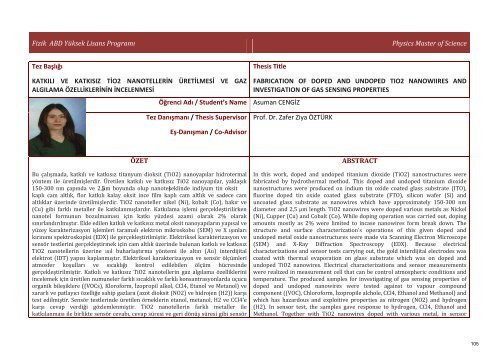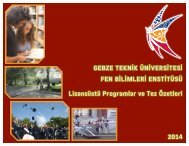GTÜ FBE Lisansüstü Programlar ve Tez Özetleri
Create successful ePaper yourself
Turn your PDF publications into a flip-book with our unique Google optimized e-Paper software.
Fizik ABD Yüksek Lisans Programı<br />
Physics Master of Science<br />
<strong>Tez</strong> Başlığı<br />
Thesis Title<br />
KATKILI VE KATKISIZ TİO2 NANOTELLERİN ÜRETİLMESİ VE GAZ<br />
ALGILAMA ÖZELLİKLERİNİN İNCELENMESİ<br />
Öğrenci Adı / Student’s Name Asuman CENGİZ<br />
FABRICATION OF DOPED AND UNDOPED TIO2 NANOWIIRES AND<br />
INVESTIGATION OF GAS SENSING PROPERTIES<br />
<strong>Tez</strong> Danışmanı / Thesis Supervisor<br />
Prof. Dr. Zafer Ziya ÖZTÜRK<br />
Eş-Danışman / Co-Advisor<br />
ÖZET<br />
Bu çalışmada, katkılı <strong>ve</strong> katkısız titanyum dioksit (TiO2) nanoyapılar hidrotermal<br />
yöntem ile üretilmişlerdir. Üretilen katkılı <strong>ve</strong> katkısız TiO2 nanoyapılar, yaklaşık<br />
150-300 nm çapında <strong>ve</strong> 2,5 μm boyunda olup nanotel şeklinde indiyum tin oksit<br />
kaplı cam altlık, flor katkılı kalay oksit ince film kaplı cam altlık <strong>ve</strong> sadece cam<br />
altlıklar üzerinde üretilmişlerdir. TiO2 nanoteller nikel (Ni), kobalt (Co), bakır <strong>ve</strong><br />
(Cu) gibi farklı metaller ile katkılanmışlardır. Katkılama işlemi gerçekleştirilirken<br />
nanotel formunun bozulmaması için katkı yüzdesi azami olarak 2% olarak<br />
sınırlandırılmıştır. Elde edilen katkılı <strong>ve</strong> katkısız metal oksit nanoyapıların yapısal <strong>ve</strong><br />
yüzey karakterizasyon işlemleri taramalı elektron mikroskobu (SEM) <strong>ve</strong> X ışınları<br />
kırınımı spektroskopisi (EDX) ile gerçekleştirilmiştir. Elektriksel karakterizasyon <strong>ve</strong><br />
sensör testlerini gerçekleştirmek için cam altlık üzerinde bulunan katkılı <strong>ve</strong> katkısız<br />
TiO2 nanotellerin üzerine ısıl buharlaştırma yöntemi ile altın (Au) interdijital<br />
elektrot (IDT) yapısı kaplanmıştır. Elektriksel karakterizasyon <strong>ve</strong> sensör ölçümleri<br />
atmosfer koşulları <strong>ve</strong> sıcaklığı kontrol edilebilen ölçüm hücresinde<br />
gerçekleştirilmiştir. Katkılı <strong>ve</strong> katkısız TiO2 nanotellerin gaz algılama özelliklerini<br />
incelemek için üretilen numuneler farklı sıcaklık <strong>ve</strong> farklı konsantrasyonlarda uçucu<br />
organik bileşiklere ((VOCs), Kloroform, İzopropil alkol, CCl4, Etanol <strong>ve</strong> Metanol) <strong>ve</strong><br />
zararlı <strong>ve</strong> patlayıcı özelliğe sahip gazlara (azot dioksit (NO2) <strong>ve</strong> hidrojen (H2)) karşı<br />
test edilmiştir. Sensör testlerinde üretilen örneklerin etanol, metanol, H2 <strong>ve</strong> CCl4'e<br />
karşı cevap <strong>ve</strong>rdiği gözlemlenmiştir. TiO2 nanotellerin farklı metaller ile<br />
katkılanması ile birlikte sensör cevabı, cevap süresi <strong>ve</strong> geri dönüş süresi gibi sensör<br />
ABSTRACT<br />
In this work, doped and undoped titanium dioxide (TiO2) nanostructures were<br />
fabricated by hydrothermal method. This doped and undoped titanium dioxide<br />
nanostructures were produced on indium tin oxide coated glass substrate (ITO),<br />
fluorine doped tin oxide coated glass substrate (FTO), silicon wafer (Si) and<br />
uncoated glass substrate as nanowires which ha<strong>ve</strong> approximately 150-300 nm<br />
diameter and 2,5 μm length. TiO2 nanowires were doped various metals as Nickel<br />
(Ni), Cupper (Cu) and Cobalt (Co). While doping operation was carried out, doping<br />
amounts mostly as 2% were limited to incase nanowires form break down. The<br />
structure and surface characterization's operations of this gi<strong>ve</strong>n doped and<br />
undoped metal oxide nanostructures were made via Scanning Electron Microscope<br />
(SEM) and X-Ray Diffraction Spectroscopy (EDX). Because electrical<br />
characterizations and sensor tests carrying out, the gold interdijital electrodes was<br />
coated with thermal evaporation on glass substrate which was on doped and<br />
undoped TiO2 nanowires. Electrical characterizations and sensor measurements<br />
were realized in measurement cell that can be control atmospheric conditions and<br />
temperature. The produced samples for in<strong>ve</strong>stigating of gas sensing properties of<br />
doped and undoped nanowires were tested against to vapour compound<br />
component ((VOC), Chloroform, İzopropile alchole, CCl4, Ethanol and Methanol) and<br />
which has hazardous and exploiti<strong>ve</strong> properties as nitrogen (NO2) and hydrogen<br />
(H2). In sensor test, the samples ga<strong>ve</strong> response to hydrogen, CCl4, Ethanol and<br />
Methanol. Together with TiO2 nanowires doped with various metal, in sensor<br />
105




